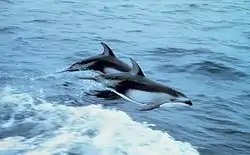Lagenorhynchus
Lagenorhynchus is a genus in the order Cetacea, traditionally containing six species:
- White-beaked dolphin (Lagenorhynchus albirostris)
- Atlantic white-sided dolphin (Lagenorhynchus acutus)
- Pacific white-sided dolphin (Lagenorhynchus obliquidens)
- Dusky dolphin (Lagenorhynchus obscurus)
- Peale's dolphin (Lagenorhynchus australis)
- Hourglass dolphin (Lagenorhynchus cruciger)
| Lagenorhynchus | |
|---|---|
 | |
| Lagenorhynchus obliquidens | |
| Scientific classification | |
| Kingdom: | Animalia |
| Phylum: | Chordata |
| Class: | Mammalia |
| Order: | Artiodactyla |
| Infraorder: | Cetacea |
| Family: | Delphinidae |
| Genus: | Lagenorhynchus Gray, 1846 |
| Species | |
|
Lagenorhynchus albirostris | |
The name Lagenorhynchus derives from the Greek lagenos meaning "bottle" and rhynchus meaning "beak". Indeed, the "bottle-nose" is a characteristic of this genus. However, the dolphins popularly called bottlenose dolphins belong in the genus Tursiops. The melon-headed whale was once classified in this genus, but was later removed to its own genus, Peponocephala.
Recent analysis of the mitochondrial cytochrome b gene indicates the genus Lagenorhynchus, as traditionally conceived, is not a natural (monophyletic) group. LeDuc, Perrin & Dizon 1999 found that the white-beaked and Atlantic white-sided dolphins were phylogenetically isolated within the Delphinidae, whereas the remaining four species were members of the Lissodelphinae, a predominantly Pacific clade of dolphins also including the right whale dolphins and the Cephalorhynchus dolphins. These findings are somewhat problematic taxonomically, since the white-beaked dolphin is the type species of the genus Lagenorhynchus; if the other species are not closely related to the white-beaked dolphin, then they must be removed from the genus. Accordingly, LeDuc et al. suggested that the Atlantic white-sided dolphin be placed within its own genus, Leucopleurus, and that the remaining species would need taxonomic revision, as well. Leduc proposed Sagmatias as the new genus for the Pacific white-sided dolphin, Peale's dolphin, hourglass dolphin and dusky dolphin.[1]
May-Collado & Agnarsson 2006 actually recovered the hourglass and Peale's dolphins as nested phylogenetically among the species of Cephalorhynchus, and they suggest these two species be transferred to that genus. Some acoustic and morphological data support for this arrangement. Both hourglass and Peale's dolphins share with the species of Cephalorhynchus a distinct type of echolocation signal known as a narrow-band, high-frequency signal.[2][3] This signal is shared with porpoises (Phocoenidae) and pygmy sperm whales (Kogiidae), but is not found among other dolphin groups. According to Schevill & Watkins 1971, Peale's dolphin and the Cephalorhynchus species are the only dolphins that do not whistle. Presumably this is the case for hourglass dolphins, as well. Peale's dolphin also shares with several Cephalorhynchus species the possession of a distinct white "armpit" marking behind the pectoral fin.
According to an analysis by May-Collado & Agnarsson 2006, the remaining two species, the dusky and Pacific white-sided dolphins, are closely related to each other and form the sister group to the (expanded) genus Cephalorhynchus. If this placement is accurate, a new genus name will need to be coined to accommodate these two species.
References
- Kyhn, LA; Jensen, FH; Beedholm, FH; Tougaard, J (June 2010). "Echolocation in sympatric Peale's dolphins (Lagenorhynchus australis) and Commerson's dolphins (Cephalorhynchus commersonii) producing narrow-band high-frequency clicks". Journal of Experimental Biology. 213 (11): 1940–9. doi:10.1242/jeb.042440. ISSN 0022-0949. OCLC 618825118. PMID 20472781.CS1 maint: ref=harv (link)
- LeDuc, R.G.; Perrin, W.F.; Dizon, A.E. (July 1999). "Phylogenetic relationships among the delphinid cetaceans based on full cytochrome b sequences". Marine Mammal Science. 15 (3): 619–648. doi:10.1111/j.1748-7692.1999.tb00833.x. ISSN 0824-0469.CS1 maint: ref=harv (link)
- May-Collado, Laura; Agnarsson, Ingi (2006). "Cytochrome b and Bayesian inference of whale phylogeny" (PDF). Molecular Phylogenetics and Evolution. 38 (2): 344–54. doi:10.1016/j.ympev.2005.09.019. ISSN 1055-7903. OCLC 441745572. PMID 16325433.CS1 maint: ref=harv (link)
- Schevill, W.E.; Watkins, W.A. (January 15, 1971). "Pulsed sounds of the porpoise Lagenorhynchus australis". Breviora. 366: 1–10. ISSN 0006-9698. OCLC 80876226.CS1 maint: ref=harv (link)
- Tougaard, J; Kyhn, LA (2010). "Echolocation sounds of hourglass dolphins (Lagenorhynchus cruciger) are similar to the narrow band high-frequency echolocation sounds of the dolphin genus Cephalorhynchus". Marine Mammal Science. 26 (1): 239–45. doi:10.1111/j.1748-7692.2009.00307.x. ISSN 0824-0469. OCLC 497138903.CS1 maint: ref=harv (link)